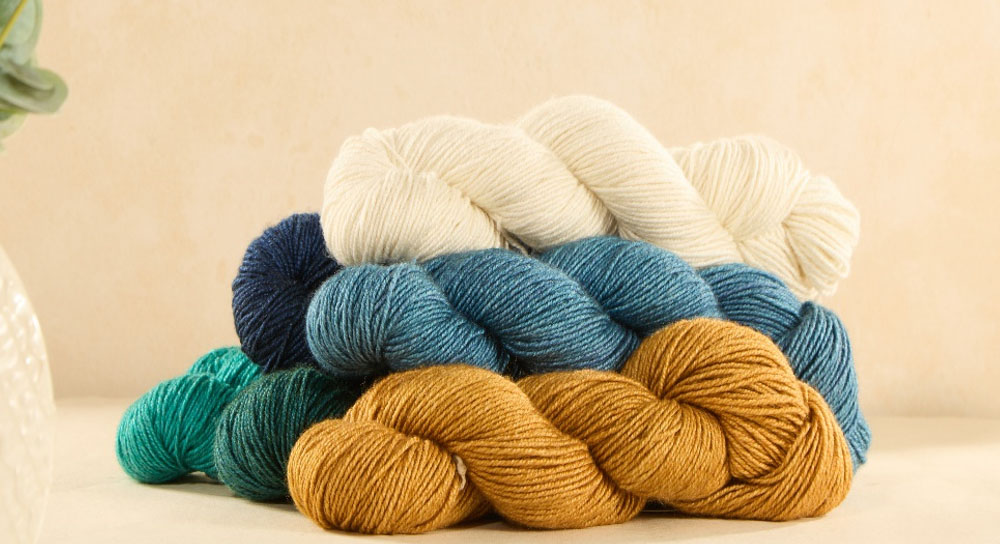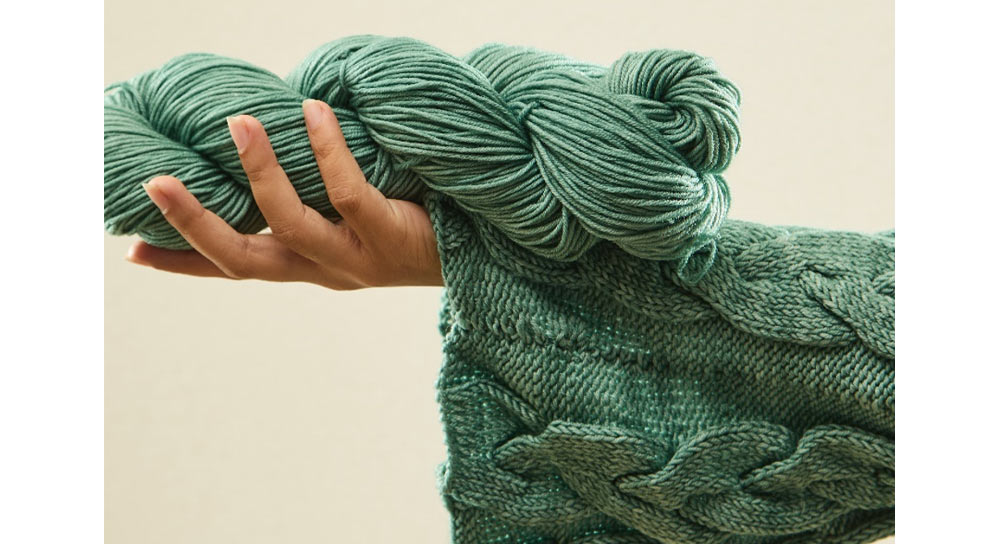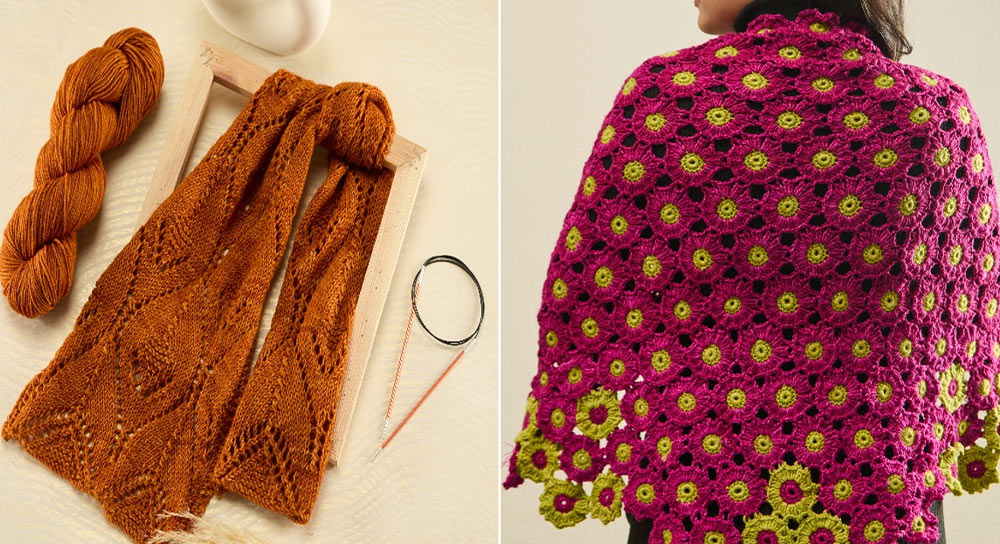Knitting or Crochet: Which Crafting Style Uses More Yarn
- Blog Views : 1212
- Symfonie Yarns
- 22Jan, 2025

Knitting or crochet, which crafting style uses more yarn? This is an age-old debate in the yarn-crafting world. Knitting and crochet both transform yarn into pretty and practical projects. Both crafts work with colorful yarns ranging from lightweight fingering to versatile DK to slightly cozy worsted to bulky yarn weights. However, both crafting styles differ in the method of using yarn. One craft works with a pair of knitting needles while the other uses a single hook to make loops of stitches. One of the major differences is, that both crafting styles have different requisites for the amount of yarn.
Generally, it is believed crochet uses more yarn, for the reason of how crochet makes loops of stitches, however, the answer is not as straightforward as it may seem. The amount of yarn used in knitting and crochet projects depends on the technique, pattern, and type of stitches. Dive into the topic of knitting vs crochet- the complete guide for yarn lovers. For yarn consumption in knitting vs crochet, in this blog, let’s find out.
We’ll walk you through:
- How Much Yarn Do I Need for a Project? Knitting vs. Crochet
- Factors Influencing Yarn Usage
- Why Crochet uses more yarn
- Exploring Symfonie Yarns’ collection
How Much Yarn Do I Need for a Project? Knitting vs. Crochet
Crafters when planning their projects always have the question of how much yarn they need. A knitted scarf and a scarf worked with crochet yarn are not the same. The difference is minimal, however, it certainly requires proper calculations before you begin a project such as a blanket or something that requires fit such as garments. Suppose you have a single skein of yarn or even less and have a project for example a cowl in mind, understanding which craft uses more yarn will help decide to go with knitting or crochet. While a pattern tries and deal with the yarn right at the beginning, the problem arises when you try to switch the crafting style, yarn weight, yarn fiber, or the stitch technique.

Crochet has a reputation for more yarn consumption but that is a statement that varies. If you compare stockinette (alternating rows of knit and purl stitches) in knitting with single crochet stitches, stockinette requires less yarn, however, if you take garter (rows of all knit stitches) with the same stitch the consumption of the knitting yarn is more in comparison to single crochet. Similarly, if you take lace patterns in crochet and lace knitting, the yarn consumption is generally more in crochet.
Factors Influencing Yarn Usage
Whether you knit or crochet, there are always few factors that influence yarn usage. It can be as simple as the crafter’s tension or gauge and as intricate as the stitches and techniques.
1. Stitches and Techniques
Both knitting and crochet have basic stitches. Knitting has two while crochet has five and all stitch patterns are based on these. The type of stitch in knitting or crochet and how tightly it is worked significantly affects how much yarn is used. Crochet stitches, such as double crochet or treble crochet, are bulkier than most knitting stitches such as stockinette. This is because crochet loops are pulled through more yarn, creating a denser fabric. However, for textured stitches such as Seed Stitch, Fishermens Rib, or Brioche compared to its crochet counterparts may use the same quantity of yarn.
2. Project Type
The kind of project whether it's a lightweight scarf, a cozy sweater, or an intricate lace shawl also plays a role in yarn usgae. For projects requiring intricate detail and less density, knitting may use less yarn, while crochet's bulkier stitches tend to demand more material.

3. Yarn Weight
The choice of yarn weight is crucial. Fingering, DK and worsted weight yarn are popular choices for both crafts. However, a project using DK-weight yarn for crochet will generally require more skeins than the same project made with knitting techniques.
The best option to find out is by making a gauge swatch. Before you begin a project always work on a swatch with the same yarn, knitting needle or crochet hooks. Block the square according to the yarn label instructions and then calculate the stitch per inch which helps you understand your gauge, estimate yarn for your project and evaluate how your project will turn out to be.
Knitting vs. Crochet: Yarn Usage Comparison
|
Characteristic |
Knitting |
Crochet |
|
Stitch Density |
Creates a thinner, more flexible fabric with interlocking loops. |
Produces a denser, more textured fabric with larger loops. |
|
Yarn Consumption |
Uses less yarn for comparable projects due to tighter loops. |
Uses more yarn because of the larger loops and more complex stitches. |
|
Texture and Design |
Smooth and delicate texture; ideal for intricate patterns. |
Bulkier and more textured; better for creating 3D designs. |
|
Project Examples |
Lightweight sweaters, socks, and lace shawls. |
Blankets, toys, and warm accessories like hats and mittens. |
Why Crochet Uses More Yarn
Crochet typically uses more yarn than knitting because of the mechanics of its stitches. Each stitch is constructed by making loops. For instance, a single crochet stitch involves pulling the yarn through multiple loops, consuming more material compared to a knitting stitch that requires only one loop at a time. Additionally, crochet stitches are larger and less compact than knitting stitches, resulting in greater yarn consumption for the same amount of fabric.
The verdict is clear: crochet generally requires more yarn than knitting. However, the choice between knitting and crochet ultimately depends on the look, feel, and purpose of your project.
Exploring Symfonie Yarns’ Collection for Knitting and Crochet Projects
With Symfonie Yarn collection explore the crafting styles of knitting and crochet. The four exclusive ranges offer endless possibilities. So, whether you knit a pair of socks with Terra’s merino-polyamide yarn in fingering weight or crochet a granny square with extrafine merino wool from Viva’s DK yarn, or work on a baby blanket with Bella’s worsted-weight yarn, you can explore any craft style and project.
Whether you're stepping into crafting or are a dedicated knitter or an avid crocheter, understanding yarn helps you plan your projects and let creativity flow.
-
- 14 Oct,2025
-
- 10 Oct,2025
-
- 06 Oct,2025
-
- 01 Oct,2025
-
- 25 Sep,2025
-
- 20 Sep,2025
Copyright © Symfonie Yarns 2025 - all rights reserved | RSS Feed
